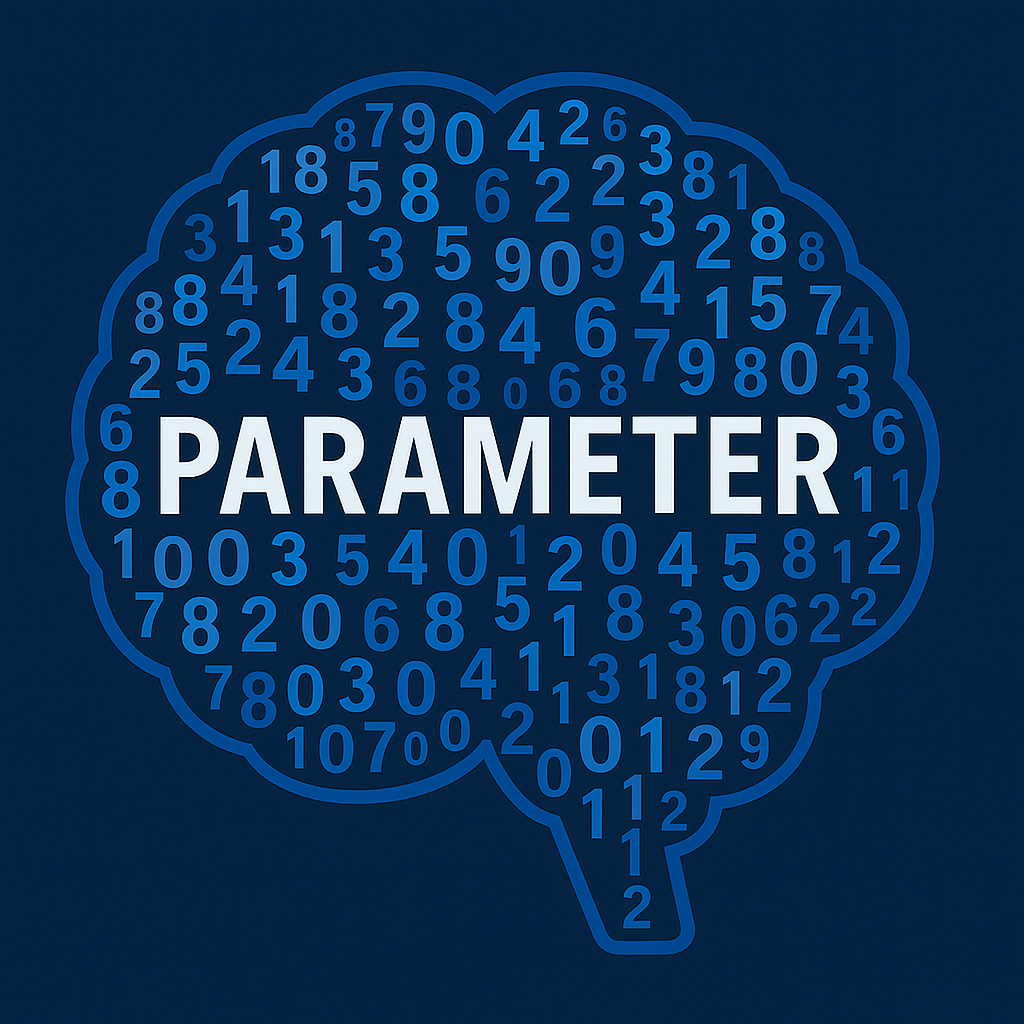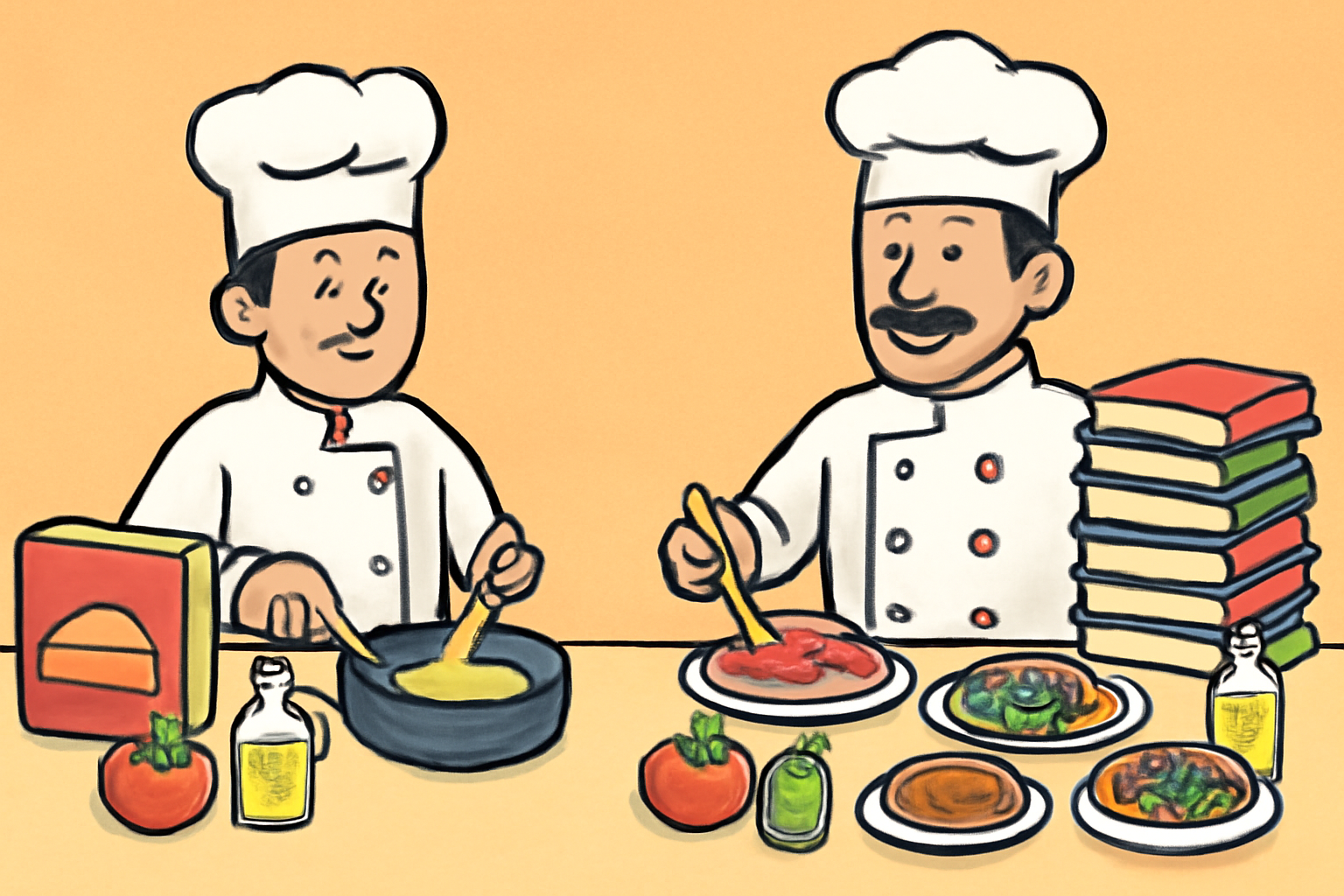AI와 머신러닝을 이야기할 때 빠지지 않는 용어가 바로 파라미터입니다.
'야놀자, AI 접목 확대....'_2025-7-9 전자신문(손지혜 기자)
- (중략) EEVE 2.0은 전 버전에 비해 학습 파라미터를 줄였다. 1.0 모델이 100억개의 파라미터를 학습했다면 2.0 모델은 70억개의 파라미터를, EEVE-Rosetta는 40억개 파라미터만 학습해 경량화를 이뤘다. 운용 비용은 감소하고 더 빠른 속도로 실행할 수 있다. 아울러 경량화를 통해 값비싼 AI 전문 GPU가 아닌 저렴한 게이밍 GPU로도 사용자에게 서비스를 제공할 수 있다.(중략) -
위의 기사를 읽어보면 야놀자에서 AI서비스를 자체 개발했고, 해당 AI모델이 학습한 파라미터의 수가 100억개에서 70억개로, 다시 40억개로 줄어들었다는 경량화에 대한 자랑을 하는 것으로 보입니다만, 도대체 이 파라미터가 많고 적음이 AI의 추론에 어떠한 영향을 미치는 것일까요? 왜 학습 파라미터를 줄여 경량화를 하는 것이 기사에 날만한 일인건지요.
궁금하면 참지 못하는 저, 그리고 여러분을 위해 오늘은 파라미터에 대해 알아보도록 하겠습니다.
🧩 파라미터란? - AI 모델의 뇌를 구성하는 숫자들

제가 애용하는 perplexity 아저씨에게 물어보니
'파라미터(parameter)란 AI 모델이 학습 과정에서 데이터로부터 스스로 찾아내는 수많은 숫자 값입니다. 이 숫자들은 모델이 입력된 데이터를 해석하고, 그에 맞는 출력을 만들어내는 데 필요한 지식과 규칙을 저장합니다.
예를 들어, 언어모델이 "고양이는 귀엽다"라는 문장을 학습할 때, 각 단어의 관계와 문맥을 수치로 기억하는 것이 바로 파라미터입니다.'
라는 답을 줍니다.
그런데 perplexity 아저씨.... 저는 아직도 파라미터에 대해 잘 모르겠습니다.
이에 퍼씨아저씨와의 대화를 통해 파라미터에 대해 조금 더 알아보았습니다.
🛠️ 파라미터의 역할은? - AI의 지식과 판단의 근거
파라미터의 역할은 AI의 뇌와 같은 역할을 한다고 합니다.
우리 인간이 보고 듣는 정보를 뇌에 전달하면 전달된 정보를 바탕으로 뇌가 판단을 하듯,
파라미터는 전달된 데이터에 대해 AI가 어떤 결과를 내보낼지 결정을 하게 하는 역할을 합니다.
즉, 지식을 저장하고 의사결정을 하는 것이라 할 수 있습니다.
ㅇ 지식 저장 : 언어의 규칙, 패턴, 상식 등 다양한 정보를 수치로 저장
ㅇ 의사 결정 : 입력된 데이터(문장, 이미지 등)에 대해 어떤 결과를 낼지 파라미터를 참고해 판단
따라서 파라미터가 많을수록 복잡한 패턴과 다양한 상황을 더 잘 이해할 수 있는 것입니다.
👨🍳 파라미터를 요리사의 레시피에 비유한다면.
이해를 돕기 위해 파라미터를 요리사의 레시피에 비유해 보겠습니다.
소규모 식당에서 일하는 1년차 요리사는 요리 재료(데이터)도 한정적이고 이에 따라 만들어본 음식의 레시피(파라미터)도 얼마 되지 않을 것입니다. 따라서 이 요리사가 만들어 내는 음식의 수 역시 한정적이고 맛도 제한적이겠지요.
그러나 오랜 경험을 보유한 대형 식당의 요리사는 풍부한 요리 재료(데이터)를 가지고 그간 만들어본 수많은 레시피(파라미터)를 통해 다양한 종류의 맛있는 음식을 만들어 낼 수 있습니다.
이렇게 볼 때 요리사의 레시피가 적다는 말은 AI의 파라미터가 적다는 말로 바꿔 말할 수 있으며,
이 요리사가 만드는 요리가 단순하고 제한적이듯이, 파라미터가 적은 AI 역시 단순하고 제한적인 답변만을 생성해 낼 수 있는 것입니다.
이와 반대로 재료(데이터)도 다양하고 수천가지의 요리법(파라미터)을 지닌 요리사가 훌륭하고 다양한 음식을 만들어 내듯이, 풍부한 데이터와 많은 파라미터를 지닌 AI모델이 더욱 정확하고 다양한 답변을 생성해 낼 수 있는 것입니다.

이를 AI의 추론 형태로 설명한다면
파라미터가 적은 모델은 단순한 패턴만 인식할 수 있기에 요청 prompt에 대한 추론 답변의 오답률이 높고, 창의적인 답변 역시 할 수 없습니다.
그 대신!
추론에 대한 실행속도는 빠르고 자원(전력 등) 소모가 적다는 이점은 있겠죠.
반대로 파라미터가 많은 AI모델은 복잡한 문맥과 다양한 상황을 이해할 수 있기에 더 정확하고 자연스러운 답변을 생성할 수 있게 됩니다.
그렇지만!
추론에 대한 계산량과 메모리 사용량이 많아짐에 따라 실행속도는 지연되고 전력 등 자원소모가 상대적으로 많을 수 밖에 없겠죠.
🤖 그렇다면 위 기사에서 야놀자가 접목한 AI는 왜 학습 파라미터늘 계속 줄여가고 있을까?
지금까지 설명한 내용만 본다면 야놀자는 AI가 학습하는 파라미터의 양을 계속 늘려서 AI가 더 정확하고 자연스러운 답변을 하게 해야함에도 왜 파라미터의 양을 줄여 경량화 했다고 자랑하는 기사를 내보낸 걸까요?
다시 요리사를 불러 설명해 보겠습니다.
풍부한 재료와 다양한 레시피를 지닌 요리사는 말한 바와 같이 훌륭하고 다양한 요리를 만들 수 있으며,
반대로 소량의 재료와 얼마 안되는 레시피를 지닌 요리사는 한정된 음식을 만들어내는 것이 당연합니다.
그렇지만!
요리사가 모든 분야의 요리를 만들어 내는 것이 아닌 특정 분야의 요리에 특화되 있다면!!!
결과는 달라질 수 있습니다.
즉, 한식, 중식, 일식 등 어느 한 분야에 특화된 요리사의 경우 다양한 재료와 다양한 음식 레시피를 지닌 요리사에 비해 만들어내는 요리는 제한적이겠지만 중식이라는 특정 분야의 음식은 잘 만들어 낼 수 있다는 것입니다.
마찬가지로 야놀자는 AI가 학습하는 파라미터를 줄여가고는 있지만, 야놀자의 서비스 분야인 숙박, 레저 등의 분야에 특화시켜 학습 파라미터를 줄여도 답변의 정확도는 유지하거나 상승시키며 자원 소모는 줄이는 개선효과를 얻은 것입니다.
이러한 경량화 효과를 신문 기사를 통해 외부에 알리는 것이고요.
📝 마무리하며
파라미터는 AI 모델의 핵심이자, AI모델이 얼마나 똑똑하게 데이터를 이해하고 결과를 만들어낼 수 있는지를 결정하는 중요한 요소입니다.
파라미터가 많을수록 AI는 더 다양한 문제를 해결할 수 있습니다.
마치 수많은 레시피를 가진 요리사가 더 맛있고 다양한 요리를 만들 수 있듯, AI도 풍부한 파라미터를 바탕으로 우리의 일상에 더 똑똑한 서비스를 제공하게 됩니다.
단, 특정 분야에 특화시키는 경우 소규모의 파라미터 학습을 통한 경량화에도 더 똑똑하게 답을 추론해 낼 수 있다는 사실!
지금까지 파라미터에 대해 알아보았습니다.
아래는 영어 버전의 글입니다.
----------------------------------
When discussing AI and machine learning, the term "parameter" is always present.
'Yanolja Expands AI Integration...'
Electronic Times, July 9, 2025 (Reporter: Son Ji-hye)
(Excerpt) EEVE 2.0 reduced the number of training parameters compared to the previous version. While version 1.0 was trained with 1 billion parameters, version 2.0 used 700 million, and EEVE-Rosetta achieved lightweight efficiency with only 400 million parameters. This reduces operational costs and enables faster execution. Furthermore, this lightweight model can provide services to users using inexpensive gaming GPUs instead of costly AI-specialized GPUs. (Excerpt)
Reading the above article, it seems that Yanolja has developed its own AI service, and is boasting about making the model lighter by reducing the number of parameters from 1 billion to 700 million, and then to 400 million. But how exactly does the number of parameters affect AI inference? Why is reducing the number of training parameters and making the model lighter newsworthy?
For those of us who can't stand curiosity, let's explore what parameters are today.
🧩 What Are Parameters? — The Numbers That Make Up an AI Model's Brain
When I asked my favorite "Perplexity uncle,"
"A parameter is one of the numerous numerical values that an AI model learns from data during training. These numbers store the knowledge and rules needed for the model to interpret input data and produce appropriate outputs. For example, when a language model learns the sentence 'Cats are cute,' it remembers the relationships and context of each word as parameters."
That's the answer I got.
But, Perplexity uncle... I still don't fully understand parameters.
So, I had a further conversation with him to learn more.
🛠️ What Is the Role of Parameters? — The Foundation of AI's Knowledge and Judgement
Parameters act as the "brain" of AI.
Just as the human brain makes judgments based on information received through our senses, parameters determine what results AI will produce from the data it receives.
In other words, parameters store knowledge and make decisions.
ㅇ Knowledge Storage: They numerically store various information such as language rules, patterns, and common sense.
ㅇ Decision Making: They guide the AI in determining what result to produce for a given input (sentence, image, etc.).
Thus, the more parameters there are, the better the model can understand complex patterns and diverse situations.
👨🍳 Comparing Parameters to a Chef's Recipes
To help you understand, let's compare parameters to a chef's recipes.
A first-year chef at a small restaurant has limited ingredients (data) and only a handful of recipes (parameters) they've tried. Naturally, the number and variety of dishes they can make are limited.
On the other hand, an experienced chef at a large restaurant, with a wealth of ingredients (data) and countless recipes (parameters), can create a wide variety of delicious dishes.
In this analogy, having fewer recipes is like having fewer parameters in an AI model—just as the chef can only make simple, limited dishes, an AI with few parameters can only generate simple and limited responses.
Conversely, a chef with diverse ingredients and thousands of recipes can make excellent and varied dishes. Likewise, an AI model with abundant data and many parameters can generate more accurate and diverse answers.
In terms of AI inference, a model with few parameters can only recognize simple patterns, resulting in a higher error rate and less creativity in its responses.
But!
Such models have the advantage of faster inference speed and lower resource (energy, etc.) consumption.
On the other hand, models with many parameters can understand complex contexts and diverse situations, producing more accurate and natural answers.
However!
As the number of parameters increases, so do the computational and memory requirements, which can slow down execution and increase resource consumption.
🤖 Then Why Is Yanolja Reducing the Number of Training Parameters?
Based on what we've discussed, you might think Yanolja should keep increasing the number of parameters for more accurate and natural AI responses. So why are they boasting about making their models lighter by reducing parameters?
Let's revisit the chef analogy.
A chef with abundant ingredients and diverse recipes can indeed make excellent and varied dishes, while a chef with limited ingredients and recipes is naturally limited in what they can produce.
However! If a chef specializes in a specific type of cuisine rather than cooking every kind of dish, the outcome can be different.
For example, a chef specializing in Korean, Chinese, or Japanese cuisine may have fewer recipes than a chef who knows every cuisine, but can make dishes in their specialty area exceptionally well.
Similarly, Yanolja has reduced the number of parameters but specialized the AI in its service areas—accommodation, leisure, etc.—so that even with fewer training parameters, the model maintains or even improves answer accuracy while reducing resource consumption.
This is the lightweighting effect being publicized in the news article.
📝 In Conclusion
Parameters are the core of an AI model and a key factor in determining how intelligently the model can understand data and produce results. The more parameters, the more diverse problems AI can solve. Just as a chef with many recipes can make more delicious and varied dishes, AI provides smarter services in our daily lives based on abundant parameters.
However, when specialized for a specific field, even a model trained with fewer parameters can infer smarter answers through lightweighting!
This has been an exploration of parameters.
'AI를 알아가다' 카테고리의 다른 글
| ⚡ AI 대격돌(AI Showdown) : Grok, Gemini, Perplexity, ChatGPT 비교 (15) | 2025.07.16 |
|---|---|
| ☁️ 실시간 날씨 질문에 답하는 AI, 그 뒤의 LLM과 RAG 이야기(AI that answers real-time weather questions: The story behind LLM and RAG) 🤖 (28) | 2025.07.01 |
| 🏞️ AI로 이미지 생성하기 실습(지휘하는 햄스터) (38) | 2025.06.18 |
| 👨🎨AI 이미지 프롬프트(prompt)를 명확하게 작성하기(구조화 방식) (25) | 2025.06.15 |
| 👨🎨AI 이미지 프롬프트(prompt) 따라하기(3) (12) | 2025.06.15 |